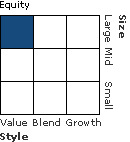| Fidelity VIP Energy Initial |
|
 |
|
| Release date as of 2025-08-31. Data on page is subject to change. |
|
|
Overall Morningstar
Rating™
|
| What is this?
|
|
 |
| As of 2025-08-31 |
|
Out of 69
Equity Energy Funds
|
|
|
|
|
|
| Total Fund Assets ($ Mil) |
| 460.35 |
|
|
|
| Investment Objective & Strategy |
|
| The investment seeks capital appreciation.
|
|
| The fund primarily invests in common stocks. It normally invests at least 80% of assets in securities of companies principally engaged in the energy field including the conventional areas of oil, gas, electricity and coal, and newer sources of energy such as nuclear, geothermal, oil shale, and solar power. The fund invests in domestic and foreign issuers. It uses fundamental analysis of factors such as each issuer's financial condition and industry position, as well as market and economic conditions, to select investments. The fund is non-diversified. |
|
|
| Morningstar Category: Equity Energy |
|
| Equity energy portfolios invest primarily in equity securities of U.S. or non-U.S. companies who conduct business primarily in energy-related industries. This includes and is not limited to companies in alternative energy, coal, exploration, oil and gas services, pipelines, natural gas services, and refineries.
|
|
|
| Sector Funds: Funds that invest exclusively in one sector or industry involve risks due to the lack of industry diversification and expose the investor to increased industry-specific risks. |
| Non-Diversified Funds: Funds that invest more of their assets in a single issuer involve additional risks, including share price fluctuations, because of the increased concentration of investments. |
|
|
| % of Net Assets |
 |
U.S. Stocks |
89.7 |
 |
Non-U.S. Stocks |
10.0 |
 |
Bonds |
0.0 |
 |
Cash |
0.4 |
 |
Other |
0.0 |
|
|
 |
| Data through 2025-07-31 |
|
|
|
|
| Morningstar Equity Sectors |
|
|
|
% of Stocks |
 |
Cyclical |
0.15 |
 |
Basic Materials |
0.15 |
 |
Consumer Cyclical |
0.00 |
 |
Financial Services |
0.00 |
 |
Real Estate |
0.00 |
|
|
|
 |
Sensitive |
95.53 |
 |
Communication Services |
0.00 |
 |
Energy |
95.53 |
 |
Industrials |
0.00 |
 |
Technology |
0.00 |
|
|
|
 |
Defensive |
4.32 |
 |
Consumer Defensive |
0.00 |
 |
Healthcare |
0.00 |
 |
Utilities |
4.32 |
|
| Data through 2025-07-31 |
|
|
| Total Number of Stock Holdings |
32 |
| Total Number of Bond Holdings |
0 |
| % of Net Assets in Top 10 Holdings |
68.59 |
|
|
| Turnover % |
(as of 2024-12-31) |
17.00 |
| 30 Day SEC Yield % |
--- |
|
|
Sector |
P/E |
% of Net
Assets
|
 |
 |
 |
 |
 |
 |
Exxon Mobil Corp |
 |
15.93 |
24.99 |
 |
Chevron Corp |
 |
20.22 |
9.23 |
 |
Cheniere Energy Inc |
 |
13.81 |
4.88 |
 |
Energy Transfer LP |
 |
13.53 |
4.85 |
 |
Marathon Petroleum Corp |
 |
26.51 |
4.82 |
 |
 |
Canadian Natural Resources Ltd |
 |
--- |
4.32 |
 |
Vistra Corp |
 |
33.39 |
4.30 |
 |
Cenovus Energy Inc |
 |
--- |
4.27 |
 |
Valero Energy Corp |
 |
64.49 |
3.62 |
 |
SLB |
 |
12.18 |
3.31 |
 |
|
 |
|
|
|
|
|
| Foreign Securities, Loss of Money, Not FDIC Insured, Nondiversification, Issuer, Market/Market Volatility, Equity Securities, Industry and Sector Investing |
|
| Show Risk Definitions |
|
|
| Inception Date: 2001-07-19 |
|
| Maurice FitzMaurice (2020-01-01) |
|
| Since joining Fidelity Investments in 1998, Mr. Fitzmaurice has worked as research analyst and portfolio manager. |
|
| Kristen Dougherty (2024-11-11) |
|
| Co-Portfolio Manager of Fidelity Advisor® Energy Portfolio, which she has managed since 2024. She also manages other funds. Since joining Fidelity Investments in 2012, Ms. Dougherty has worked as a research analyst and portfolio manager. |
|
|
|
| Fidelity Management & Research Company LLC |
|
|
|
|
|
| FMR Investment Management (U.K.) Limited |
| Fidelity Management & Research (Japan) Limited |
| Fidelity Management & Research (HK) Ltd |
|
|

© Copyright 2025 Morningstar, Inc. All rights reserved. Morningstar, the Morningstar logo, Morningstar.com, Morningstar Tools are either trademark or service marks of Morningstar, Inc. The information contained herein: (1) is proprietary to Morningstar and/or its content providers; (2) may not be copied or distributed; and (3) is not warranted to be accurate, complete or timely. Neither Morningstar nor its content providers are responsible for any damages or any losses arising from any use of information. Past performance is no guarantee of future performance. |
|
Past performance is no guarantee of future results.
Returns will vary and shares may be worth more or less than their original cost when sold.
|
|





















